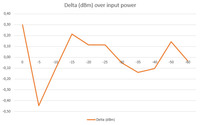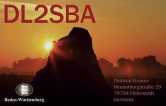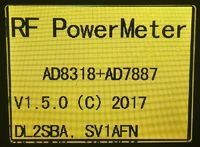My new U3S is online :-)
I've read the PA bias study from Hans and tried to tweak the PA of my U3S for optimum harmonics suppression etc. The spectrum is measured using an SIGLENT SSA3021X analyzer. The power is measured using a 40dB tap and a cheap 20w Dummyload from Diamond:  The tap is based on the work of OZ2CPU.
The tap is based on the work of OZ2CPU.
Some times ago, I found for me a solution, how to handle the unstable readings from the ADC. I've described it in this post.
In the meantime, some HAMs also build the RF powermeter based on the work of Makis, SV1AFN and myself. One if these HAMs, PA3AXA Rens, digged a little bit deeper and analysed the problem in detail. Here his description.
I've created a new firmware for the hamware AT-515 tuner.
Please check a detailled description in this manual (currently German only)
*** The RAW-Mode for the interface is no longer supported ***
Some parts are available at cost price. Please check here.
Für die Anwender von relativ kurzen Antennen auf den Bändern 160m und 80m habe ich die Firmware dahingehend erweitert, dass für 160m bzw. für 80m ein noch freier IO-Port des Mikrocontrollers aktiviert wird.
An diesen Port kann dann über eine geeignete Steuerstufe z.B. ein Relais angeschlossen werden, welches z.B. eine Spule in die Antenne einschleift um dennoch eine Abstimmung mit dem AT-502 zu ermöglichen.
Eine ausführliche Beschreibung ist hier zum Download verfügbar. Ein programmierter Mikrocontroller wird zum Selbstkostenpreis inklusive Versand in Deutschland für 15€ abgegeben.
Nach einem Hinweis von Udo, DL4EN habe ich die im Handbuch beschriebene CI-V Schnittstelle überarbeitet.
Generelle Informationen zur neuen Firmware finden sich hier.
Die aktuelle Version steht hier zum Download bereit.
Die neue Firmware für das AT-502 Steuergerät wurde erfolgreich im Umfeld der Internet-Remote-Base Station von P02-Esslingen getestet.
Mit der dort verwendeten Software von W4MQ und dem TS-2000 von Kenwood funktioniert die automatische Abstimmung einwandfrei.
Demnächst wird wohl dort auch ein AT-502 Tuner seinen Dienst verrichten.
So - eben mit Karl, DK5LP life getestet; die Kenwood Version funktioniert bei Ihm zusammen mit RUMLOG, dem ELECRAFT K2 und dem alten AT-502 Tuner mit 128 Stufen für die Induktivität wunderbar ... 
Bei Interesse einfach eine Diese E-Mail-Adresse ist vor Spambots geschützt! Zur Anzeige muss JavaScript eingeschaltet sein! an mich schreiben. Ein programmierter ATMEGA32 kostet mit Versand 15€.
Eine detaillierte Beschreibung gibt es hier zum runterladen.
Karl, DK5LP, hat mich auf eine Besonderheit des Logbuchprogrammes RUMLOG für den Mac aufmerksam gemacht.
Dieses nutzt nicht den bisher implementierten IF-Befehl des Kenwood-Protokolls sondern den FA-Befehl.
Ich habe die Firmware entsprechend erweitert, somit sollte auch RUMLOG funktionieren.
Die Beschreibung, entsprechend ergänzt, ist hier zum runterladen.
I've build a simple distribution amplifier for my GPSDO.
My SYMMETRICOM GPSDO 090-03861-03 with firmware release 1.0.0.2-01 has a bunch of commands available:
I've done some long term measurements on my GPSDO. The GPSDO has a RS232 based simple command interface.
To have a stable 10MHz reference in my shack, I've ordered a SYMMETRICOM based GPSDO from an Chinese eBay seller. It was delivered in kit form, so no issues with missing CE marking etc.
The GPSDO is build into a sturdy aluminium case with a PCB front panel and an aluminium back panel.
With the firmware version 1.8.0 I've introduce the capability to display also the input power in Watt instead of dBm. Simply tap on the unit field on the display to toggle between dBm and Watt.
I've introduced with the firmware version 1.7.1 a complexity to this project which may not be suitable to all users.
WIth the firmware version 1.7.2 I've reduced the complexity by removing the remote configuration utilities.
If you are using my powermeter software in conjunction with Maki's module and have a unstable readings or sporadic extrem value changes, this is a problem of the CS pin. It may be a grounding issue - Makis is currently analysing the problem.
I've developed a new firmware for my RF Powermeter. In this firmware, the user can now program for six calibration points the factors for the polynimial regression functions.
Therefor I've developed a JAVA GUI application for downloading these floating point values to the device.
*** CAUTION ***
All stuff described in this post is ONLY running on an Arduino which runs the OptiBoot bootloader. The EEPROM capability of the OptiBoot bootloader is needed for the features of firmware V1.7.1
I described here a way how to flash the OptiBoot loader on an Arduino UNO clone. For this you need an ISP or a second Arduino to act as an ISP.
The original library from Dan is not working as expected for me. So I adopted the code a little bit.
You can find the changes below. You can also download "my version" of the library here. Unzip into the Arduino's library folder.
As described here, I've build an RF Powermeter.
The basic firmware is now running. So I started analysing the accuracy of the used meter head.



